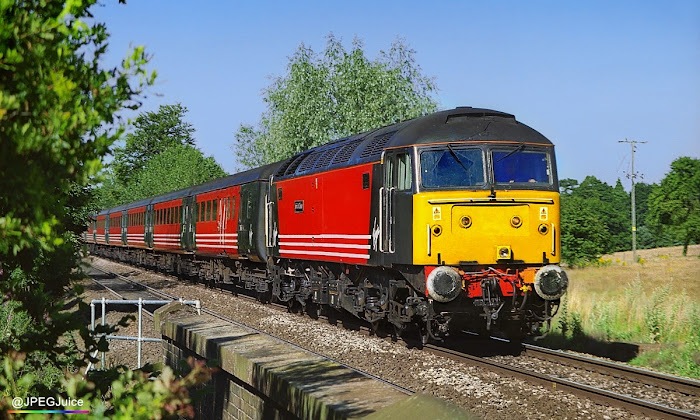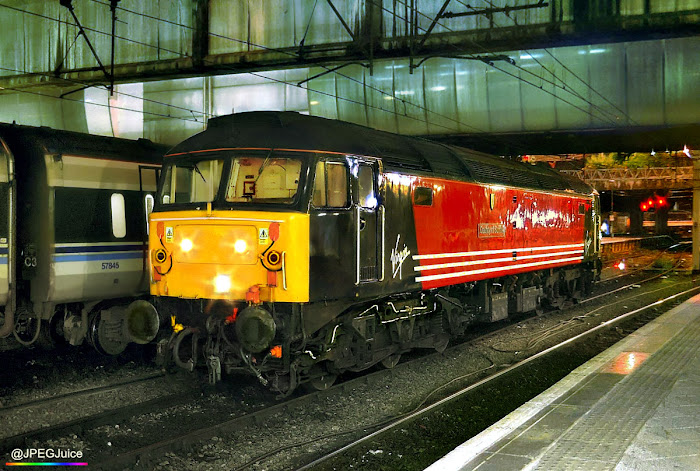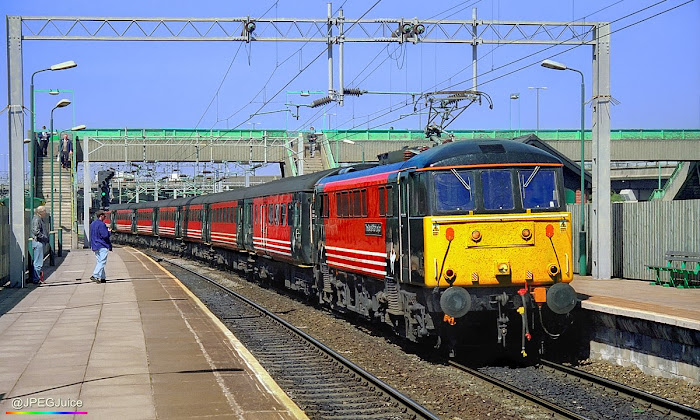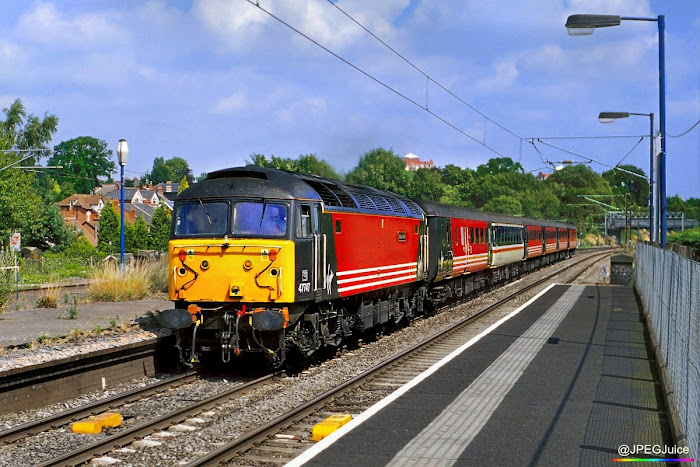"Very, very, very briefly in early spring '97, Virgin outshopped the Class 43 with “XC” branding and a dark grey cab roof."

A year ago, I said that in the post-BR era, EWS was the UK rail operator with the greatest enthusiast appeal. But is that true? Well, some might argue that a passenger operator would have higher enthusiast appeal than a freight operator, since its trains were, or are, available to the public for daily travel. And that's an altogether richer experience than simply watching trains. It's open to debate. But if you do believe that the enthusiast's choice in privatised UK rail companies would have to be a passenger service provider, then surely the leading contender is Virgin Trains, in its early phase, when the whole caboodle comprised ex-British Rail stock.

The original Virgin red livery was very pleasing to the eye when side-lit in strong winter sunlight. This is 87034 'William Shakespeare' at Dudley Port canal junction in February 2001 - the year in which the highest number of train stock items wore this aesthetic.
I've already looked at various facets of Virgin Trains in those early days, but in this post I'm showcasing the 1997 to 2001 Virgin livery, alias red and charcoal, or “Kit-Kat”. Heading the post, there's an archetypal vision from the period: Class 47/8 No. 47841 Spirit of Chester, drifting down the Lickey Incline with the 14:34 Newcastle - Bristol CrossCountry express.

86229 'Lions Clubs International' - the first Class 86 to wear the Virgin red livery.
In the late 1990s, a range of other passenger operators competed with Virgin for enthusiast attention. TOCs offering loco-haulage included Anglia (Class 86/2), Cardiff Railway Company (Class 37/4), First North Western (Class 37/4), First Great Western (Class 47/8), Gatwick Express (Class 73/2), GNER (Class 89, 90 and 91), Silverlink (Class 31), ScotRail (Class 37/4, 47/7 and 90), and Wales & West (Class 37/4).
Some operators were hiring their locomotives from EWS, which meant that EWS did have a daily presence on the passenger scene after all. EWS also supplied locos to Virgin when their native fleet fell short. Silverlink's Class 31s were supplied by Fragonset - another loco-hire company that reinforced Virgin stocks on demand.

Before the arrival of the Virgin Voyager, the HST was the flagship train on CrossCountry. The striking Virgin livery brought these well-established stalwarts new fans, as well as rekindling enthusiasm among old fans. This is 43100 'Blackpool Rock', with vinyl name graphics, ready to tackle the Lickey Incline at Aston Fields, Bromsgrove.
But no other passenger operator offered either the scale or the variety of Virgin Trains. Virgin services covered much of the UK mainland, natively utilising members of classes 43, 47/7, 47/8, 86/2, 87/0, 90 and 158. And arguably, since most of the runs were pre-scheduled, also Class 55 between 1997 and 1999. Spot hires additionally brought in pretty much every loco type you could imagine.
In beautiful spring weather on 24th April 2002, 47848 'Newton Abbot Festival of Transport' is seen en route from Liverpool to Plymouth, from the Redditch platform at Barnt Green station. The livery's ubiquity was receding by this time, and this loco-hauled CrossCountry traffic would reach the end of its official timetable in less than four months.
But Virgin differed from most other operators of locomotive-hauled trains in that its services had a visual corporate identity, which eventually extended across almost the whole native stock inventory. The strong, bold and eyecatching Virgin livery. Other TOCs, such as Anglia and Great Western, ran loco-hauled trains with a company aesthetic, but neither approached the kind of network presence that Virgin had. Indeed, by the winter '99 timetable, FGW's only loco-hauled trains were the Up and Down “Midnights” - one train in each direction per night, between Paddington and Penzance.
In contrast, Virgin ran triple digits of loco-hauled (or loco-propelled) services every day, along with 22 full HST-powered diagrams per day on CrossCountry (i.e. 22 separate sets), and another 2 on West Coast.
RISE AND FALL OF THE OLD VIRGIN LIVERY

The first recipients of the Virgin livery were HSTs. The very earliest repaints are easy to spot in pictures because they had “XC” CrossCountry branding and the power cars had a yellow cab roof. I call this livery, as seen above on 43093 Lady in Red, “yellowdome”.

43063 'Maiden Yoyager' was part of the first Virgin liveried train and was named on the first day of Virgin XC service - 5th January 1997. This shot of the power car comes from Coseley station on 15th June 2000, and as you can see it still retained its original look. However, it would very soon lose its "yellowdome" and XC branding, and its historic name would be transferred to the pioneer Class 220 before the end of the year.
The first Virgin red power car - 43063 - was actually repainted at the end of 1996, before any Virgin franchise commenced, but not branded until the start of 1997. The yellow cab roofs were abandoned on new repaints in a matter of weeks, but existing examples broadly retained them until their next scheduled repaint. Very, very, very briefly in early spring '97, Virgin outshopped the Class 43 with “XC” branding and a dark grey cab roof. 43092 emerged in that style. I'm not aware of any others. The "XC" branding was dropped once the West Coast franchise went live. That was technically in March '97, but work in progress was completed as originally planned, so "XC" was applied until April '97.

The "XC" branding was removed from the remaining "yellowdomes" in summer 2000, shortly before they were repainted. Here's a rare shot of a "yellowdome" in the short period after branding removal and before its second Virgin repaint, with a standard dark grey cab roof. This is 43153 'The English Riviera' at Birmingham International on 28th August 2000.
After the adoption of West Coast, Classes 43, 87 and 90 were repainted the most quickly, and the Class 86s were repainted the slowest.

This photo appears elsewhere on the blog, but it's a great view of an original 47/7(a) type, of which there were just two in the Virgin fleet - both adopted at the end of summer 1998 and withdrawn by 2000. This is 47702 'County of Suffolk' at Birmingham New Street. It's partner, 47711, was definitely given its Virgin colours at Loughborough works (see main text for details). Judging by the unusual implementation of the livery, with numbers on the 'wrong' cabsides - common only to these two locos, and the fact that the duo were adopted and repainted around the same time, I'd guess that '702 was a Loughborough repaint too.
The Class 47 repaints started within the first quarter of 1997 and were progressing fairly quickly until their maintenance base was switched from Crewe to Toton (March 1998), and Toton's paint shop went out of use. Loughborough could be (and was) used as an alternative on occasion. 47711 County of Hertfordshire attended Toton open weekend in NSE livery at the end of August 1998, but was immediately dispatched to Loughborough for its Virgin repaint. In the year between January 1999 and January 2000, however, only one Virgin 47 was repainted. The majority of the ILRA 47/8s were repainted in Virgin red at accelerated pace between spring 2000 and September 2001.

The Class 86 was much slower to receive Virgin red than any other Virgin loco class. Although the first Virgin branded 86 - 86245 - was outshopped in early 1998, it wasn't actually red. It was Caledonian blue, and it looked pretty grim. It took until spring '98 for a red one to appear, in the shape of 86229. Having lost its Sir John Betjeman nameplates, '229 was fairly promptly re-christened Lions Clubs International. It's seen above getting the “right away” at Sandwell and Dudley station.

The Class 90 and 87 repaints were completed first, in 2000. During a stop at Coventry station in September 2002, 90008 demonstrates the styling as applied to the former.

The former ECML "DVT" power cars, with buffers, were all with Virgin in the late 1990s. Full batch: 43013, 43014, 43065, 43067, 43068, 43080, 43084 and 43123. These vehicles received Virgin red repaints early on, and none retained InterCity livery by 1999. This is 43067 at Bournville.
Arguably, the Virgin Class 43 repaints were never completed, because the final InterCity survivor - 43029 - was transferred to First Great Western before it got its livery update. However, its replacement - 43104 - needed a Virgin repaint anyway, so its fair to say that '029 would have been repainted at that time had it stayed. Therefore, the 43s can be considered to have been repainted by spring 2001. And by then, some power cars - including the former “yellowdome” jobs - had received two full Virgin red repaints.

47826 was the only Class 47/8 in the long-term Virgin fleet never to be repainted Virgin red. It was instead given this heritage InterCity livery early in November 2001, and re-united with its old 'Springburn' nameplates.
The 47/8s were categorically never completed, as the final InterCity survivor - 47826 - stayed with Virgin but received a heritage IC repaint (as part of the heritage repaint programme) rather than Virgin red. The 47/7(b)s weren't completed either, but since they'd only joined the fleet in 2000, the fact that one was withdrawn the following year still wearing Res livery was not a great surprise.
The Virgin Class 86 repaints were not completed. Several examples were still in InterCity colours when withdrawn.

The only class in the original Virgin fleet that completely missed out on the red and charcoal livery was the 158. All five of Virgin's Express Sprinters were fitted with snowplough-style fairings, and wore the Regional Railways Express livery throughout their tenure with CrossCountry. They also notably carried yellow first class marker strips. 158750, shown above, still sported British Rail 'EXPRESS' branding at the time of the photo, at Solihull, in August 1999. The branding had been removed by the time I next photographed it at Leamington in June 2000.

On Mayday - 7th May - 2001, rail traffic was routed off the Stour Valley line, and travelled from Wolverhampton to New Street via Bescot. Virgin XC's 10:17 Manchester - Birmingham was a booked Class 86 turn at the time, and on the date in question produced 86244. This was almost the peak of prevalence for old Virgin Trains red.
If you wanted to capture the Virgin red livery on camera, arguably the best year to do it was 2001. Almost all of the original fleet remained in traffic, and the great majority of it had by that time been repainted in company garb.
However, 2001 would have been too late to catch the original “yellowdome” CrossCountry HST livery, as the handful of power cars had been revised into the standard Virgin Trains version by then. And the two Virgin red Class 47/7(a)s had been withdrawn, leaving only the 47/7(b)s.

47747 'Graham Farish' was representative of the Class 47/7(b) type. A small batch of these came to Virgin after their mail work with EWS was taken over by Class 67s in 2000.
It should be noted that there was never a time at which types 47/7(a) - former Scottish push-pull - and 47/7(b) - former Mail sector - were simultaneously working in Virgin livery. The last 47/7(a) ended Virgin service in June 2000, and the first Virgin repaint for a 47/7(b) didn't come until the following month. So you couldn't pick an overlap period and witness both types in service, in Virgin red, on the same day.
The XC power cars and 47/7(a)s were still around in 2000 though, so whilst fewer actual trains were Virgin red at that time, it would be possible to see the highest number of livery variations... If you don't count the new Virgin red/white/silver style as applied to the Voyager - which did not make its service debut until May 2001.

By the time of this shot in 2004, CrossCountry was a wall-to-wall Voyager-fest, and the Pendolinos were in service on Virgin West Coast. The Virgin Class 86s had been withdrawn and the 90s had been transferred away. Nevertheless, some full Virgin red trains did remain, as we see at Tile Hill, as 87031 heads for London Euston. The sister loco at the rear of the train should be propelling, but has failed. By the following summer, this would be all over, and the sliver of remaining loco-haulage on West Coast would employ hired EWS Class 90s.
From late 2001 and going into 2002, some of the Class 47s were repainted out of Virgin red into celebrity liveries, and the main programme of withdrawals had commenced, with the 47/7s going back to their owner - EWS, and the first 47/8s going for scrap. Additionally, some Class 47/8s had been set aside for Class 57 conversion. So by early 2002, the prevalence of old Virgin red had peaked and was now waning. By autumn that year, Virgin HSTs were dropping out of the picture too.
Although the livery would survive the decade, its familiarity across old haunts diminished fairly quickly forward from 2002. Renewal on the West Coast electric routes took longer than on CrossCountry, but by summer 2005, a full train with the old Virgin livery was a rare sight.

During the Proof House Junction remodelling in summer 2000, New Street was inaccessible at the Derby end and the NE-SW and SW-NE HSTs were diverted via Camp Hill to bypass New Street. At St Andrews on 12th August 2000, 43067 is caught on the diversion. The train will have called at Longbridge so that passengers could use the Cross City link to New Street.
The rarity of a full old Virgin red train by late 2005 was quite remarkable given how phenomenally ubiquitous the livery had been just four years earlier. Including power cars, in the region of 150 locos had sported old Virgin red in 2001, along with almost all of the coaching stock in the Virgin inventory. It seemed bizarre that finding just one complete Virgin train in original red and charcoal just four years later was such a challenge.

The dramatic arrival of the Class 220 ushered in a new red and silver image for Virgin Trains. Above you can see the original red-badged appearance of the 220, before the supplement of the Class 221 prompted a change of badge colour for the 220, to silver. The same concern about 220s and 221s being accidentally confused with each other brought a decision to number the 221s into the 1xx series. Belgian-built 221s actually arrived in the UK with 2210xx numbers, and were renumbered into the 2211xx series after delivery.
Although the Voyagers went into service in May 2001, they had virtually no presence here at Northfield station until 2002. Training runs, like this one, were among the only 220 unit sightings one could witness on the Birmingham to Gloucester line in 2001. The Voyagers were in fact totally held off the North East - South West route by the Virgin HSTs until 18th February 2002, when the very first NE-SW Class 220 diagram commenced between Bristol and Newcastle. Two Voyager namings marked the occasion. 220011 was named Tyne Voyager at Newcastle, and 220027 was named Avon Voyager at Bristol.
But "progress" was swift, and just eight months later, traffic on this line could almost have been described as a Voyager whitewash. In some places, the era of original Virgin red was already at an end. One of the great corporate rail images of the privatised era was slipping into history.
Don't forget there are more posts about Virgin Trains in this early era on the blog.
